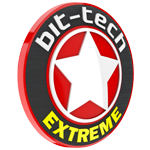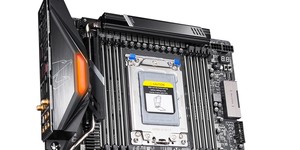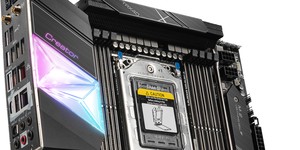Overclocking
Dealing with the heat and power requirements of an overclocked 24-core CPU is no easy feat, but we hit 4.35GHz on our Ryzen Threadripper 3960X suing a Vcore of 1.325V. Even here the VRM fans on the board only activated in the last couple of minutes of our 10-minute stress test, which goes to show that combined with half-decent airflow in a well-ventilated case, the Zenith II Extreme is more than up to the task of dealing with AMD's new CPUs. Temperatures were just about manageable and it was more about cooling capacity than instantly hitting the red-line, as you might expect from a Core i9-9900K. Our EKWB Phoenix 240 is one of the most potent 240mm liquid coolers out there and we were probably pushing its limits here, but temperatures still stayed below 85°C under load. To see Asus' latest AMD-based EFI and software you can take a look at our X570 launch coverage here.
Performance Analysis
As the first board to go through our benchmark marathon using AMD's TRX40 chipset, we don't have too many comparison numbers just yet but we have more TRX40 boards in the works. However, what we can say before taking a look at the data we can compare from the audio and storage tests, is that the board performed flawlessly, which is more than could be said for some of the first-generation X399 boards we came across. It was happy to sit at a memory frequency of 3,466MHz, overclocking was easy and everything performed as expected. Considering this is in part a new platform with new CPUs, we were pleasantly surprised.

Overclocking yielded some benefits, with most multi-threaded benchmarks seeing a boost to performance thanks to the all-core boost rising from 4.1GHz to an all-core overclock of 4.35GHz. For instance, Cinebench increased from 13,785 to 14,731 and this cut the Blender benchmark time from 25 seconds to 23 seconds, too. However, the single-threaded score fell in line with the loss of the 4.5GHz peak boost, from 514 to 500. Far Cry 5 seemed to prefer the higher all-core overclock to the stock speed boost frequencies, though, boosting the average frame rate by 6fps but the difference in Time Spy was minimal.
The audio results were excellent with one of the lowest noise levels we've seen of -116dBA and dynamic range of 114dBA, which are good even for Realtek ALC1220 standards. There was no problem dealing with our PCIe 4.0 SSD either, with the Zenith reaching a 4,836MB/sec read speed and 4,268MB/sec write speed. The SSD hit a maximum 54°C using the DIMM.2 module, which for a non-active-cooled M.2 heatsink is excellent, too. Power consumption was a little high at stock speed at 132W, rising to 172W when overclocked. We have no comparison numbers here, but we usually see this fall as BIOS versions mature so we can't really be too harsh will we've tested the competition.

Conclusion
If you're in the market for a TRX40 motherboard then you'll likely have realised already that it's not going to be cheap. However, there are already some significantly cheaper options than the ROG Zenith II Extreme out there, with the ROX Strix TRX40-E sitting at less than £500 and the Prime TRX40-Pro costing a little over £400. That's still not particularly affordable, especially compared to the cheaper X299 motherboards out there, but it cements the Zenith as an extreme motherboard with an extreme price, rather than a necessity, even though we're talking about the most powerful desktop CPUs ever created.
We can't help but marvel at its magnificence, though, and the ease with which it dealt with both 32-core and 24-core 3rd Gen Threadripper CPUs in our launch coverage. It remains to be seen if you need its lavish power delivery and cooling to deal with AMD's latest and greatest, but if you must have the best and have a suitably large wallet, you won't be disappointed and we'd certainly do the same if money were no object. For the rest of us, though, it's worth waiting for cheaper board reviews.


MSI MPG Velox 100R Chassis Review
October 14 2021 | 15:04









Want to comment? Please log in.